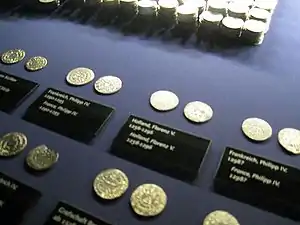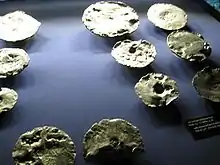Erfurt Treasure
The Erfurt Treasure is a hoard of coins, goldsmiths' work and jewelry that is assumed to have belonged to Jews who hid them in 1349 at the time of the Black Death pogroms. The pieces were found in 1998 in the wall of a house in a medieval Jewish neighborhood in Erfurt, Germany.[1]
| Erfurt Treasure | |
|---|---|
 Some of the coins on display. | |
| Material | Gold, silver, bronze, iron, and organic material |
| Created | 14th century |
| Period/culture | Middle ages |
| Discovered | Erfurt excavations in the city centre, 1998 |
| Present location | Old Synagogue (Erfurt) |
History

The treasure was discovered in 1998 by archeologists in the Michaelisstrasse under the wall of a cellar entry. It consists of silver coins and ingots as well as over 700 extraordinary works of gold smith work dating to the 13th and 14th centuries. The majority of the treasure is made up of 24 kilograms of silver coins and ingots. The 3141 coins are all Tornesel, from the late 13th and early 14th century, thus making up the largest single find of this type of coin. In addition, there are 14 ingots of various sizes, with all of them except one stamp marked.[2]
There are also 11 pieces of silver tableware including a Doppelkopf (a common form of cup in the 14th and 15th century), a shallow drinking bowl, a jug and 8 goblets that fit into each other. The latter are adorned with gothic arcades that have been gilded, these date to the first half of the 14th century.[2]
The jewelry includes 8 brooches of various sizes set with ornamental stones, the largest brooch measuring 7 cm across. Among the 8 finger rings, one is a Jewish wedding ring.[2] This outstanding piece is made of gold with a bezel composed of openwork Gothic tracery, capped by a facetted steeple. Made in the early fourteenth century, it is one of few existing medieval Ashkenazi wedding rings. The ring features a beautifully crafted, ornate, miniature version of a gothic tower and six engraved Hebrew letters that spell out mazal tov, meaning "good fate" or "good luck", on the tower's roof. In accord with Jewish tradition, the magnificent wedding ring is made entirely of gold without the addition of stones.[3] Only two other Jewish wedding rings from the first half of the 14th century have so far been found in Central Europe (Colmar and Weissenfels).[2] The jewellery in particular has drawn the attention of scholars, since little fourteenth-century jewelry survives, as jewelry was often melted down when it was deemed out of style and its value as bullion outweighed other considerations.
Besides the coins, the majority of individual pieces is accounted for by garment appliques and belt adornments (totaling 600 pieces).[2] Dozens of garment appliques are an extremely unusual find. These are small, silver sequins in various shapes, intended to be sewn onto garments. They were at the height of fashion in the fourteenth century, but, because they were made of solid silver, when the fashion changed all were melted down. The few surviving examples are almost all part of ecclesiastical textiles owned by churches. Erfurt provides rare evidence of the use of such ornaments in secular clothing.
Similar treasures were hidden in times of acute distress for the Jewish community at Colmar, Weissenfels, Lingenfeld, Münster and Środa Śląska. The Erfurt treasure, however, is larger by an order of magnitude than any of the others.
The last owner of the property in question before the pogrom of March 1349, known as the Erfurt massacre, was a Jewish moneychanger named Kalman von Wiehe, who possibly was the treasure's owner.[2]
Exhibitions of the Treasure
An exhibition, "Trésors de la Peste Noire", at the Musée National du Moyen Âge in the Hôtel de Cluny, Paris, April–September 2007 brought objects from the treasure together with the Colmar Treasure.
An exhibition, "Erfurt: Jewish Treasures from Medieval Ashkenaz," was on display at the Yeshiva University Museum of the Center for Jewish History in New York City, September 9, 2008 - January 29, 2009.[4]
The treasure was displayed in London at the Wallace Collection and at Beth Hatefutsoth in Tel Aviv, before going on permanent display at the newly conserved, eleventh century Old Synagogue museum in Erfurt.[5]
See also
Notes
- Jewish life in Erfurt. Erfurt Treasure (Accessed: 3 June 2017)
- Stürzebecher, Maria (June–July 2014). "Zwei Schätze: Zeugnisse jüdischer Kultur in Erfurt". Archäologie in Deutschland (in German). Darmstadt: WGB (3/2014): 32–35. ISSN 0176-8522.
- "Jewish Treasures From Medieval Ashkenaz At Yeshiva U. Museum" Archived 2008-12-26 at the Wayback Machine; illus. the wedding ring
- "Opening Reception for the Exhibition "Erfurt: Jewish Treasures from Medieval Ashkenaz" at the Yeshiva University Museum" September 8, 2008". Archived from the original on December 5, 2008. Retrieved November 7, 2008.
- "Jewish Treasures From Medieval Ashkenaz At Yeshiva U. Museum" Archived 2008-12-26 at the Wayback Machine
Further reading
- Stürzebecher, M. (2010), "Der Schatzfund aus der Michaelisstrasse in Erfurt" (German), in: Ostritz, S. (ed.), Der Schatzfund: Archäologie - Kunstgeschichte - Siedlungsgeschichte. Die mittelalterliche jüdische Kultur in Erfurt. Vol. 1, pp. 60–323.
